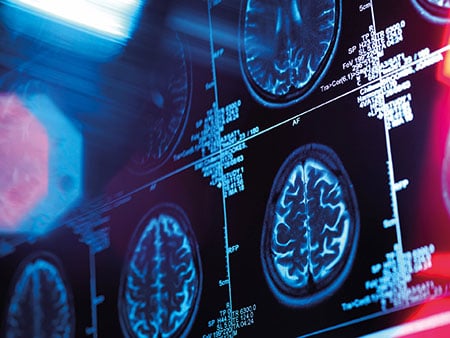Audio Version: Press Play to Listen
As teleradiology programs often cover after-hours and nighttime radiology reads, their coverage is essential to the continuity of critical patient care. In the case of the VA NTP, the team had to be able to respond to stat reads from 120 different VA facilities across the country. Complicating matters was the fact that the imaging studies were not standardized across these facilities.
When Blackford partnered with the VA NTP to assist with triage of intracranial hemorrhage (ICH) studies, we saw that the first challenge was to focus on standardizing aspects of the varied imaging data set.

Standardized Data is an Essential Element for AI Success
Almost every imaging center and radiology department faces challenges with imaging standardization. Analytical algorithms such as AI applications work best on homogeneous data sets in order to provide accurate, reproducible results. With the VA NTP, the data comes from a variety of scanners of different ages, protocols, naming conventions and more, making it one of the most diverse data sets in the country.
Blackford first deployed our software, a platform that enables radiology groups and healthcare organizations to easily integrate AI algorithms through a single source. Next, Blackford and the VA NTP focused on standardizing naming conventions. The Blackford team built an engine that homogenized the series naming conventions in order to ensure that the studies were routed and identified properly for analysis.
Identifying the best AI for the job
The next step was to focus on improving triage of ICH cases for the VA NTP. Working with Blackford, they identified an appropriate application for ICH triage to test. Unfortunately, the first AI application tested did not perform as well as the neuroradiology team had expected.
As the VA NTP had already integrated the Blackford Platform into their environment, it was a seamless process for Blackford to work with the VA NTP to identify another application that might prove a better fit and switch to this ICH algorithm for evaluation. There were no additional integrations required.
Blackford tested the Avicenna.AI algorithm in the VA NTP environment on their data, orchestrating all interactions with their PACS and neuroradiology teams, as well as Avicenna.AI.
The neuroradiologists saw significant improvement in Avicenna.AI‘s ability to provide automated detection and prioritization of acute intracerebral hemorrhage studies, including the subtle ICH cases, and to localize them. NTP PACS Administrators also found that their strategy of deploying AI applications on the Blackford platform made it an easy, single-source process.
Expanding AI use cases via the Blackford Platform
Having successfully implemented Avicenna.AI, the VA NTP is now working with Blackford to integrate breast imaging AI into the platform.
The first breast AI application will help them to understand if the quality of the imaging study is satisfactory for a read almost immediately after the scan is complete.
In addition, the team will be using AI to assist with required quality and guideline compliance reporting.
Partnering with Blackford and leveraging the platform and tailored services approach is making the identification, evaluation and deployment of AI into the VA NTP’s environment straightforward, allowing the team to focus their efforts on additional use cases where AI can help them realize ongoing value.
About the Department of Veteran’s Affairs National Teleradiology Program (VA NTP)
The VA NTP provides 24/7 diagnostic radiology services to Department of Veterans Affairs (VA) medical facilities located in all Veterans Integrated Service Networks (VISNs), rendering final diagnostic interpretations on a wide variety of modalities including, computerized tomography scans (CTs), X-rays, magnetic resonance imaging (MRI), ultrasound, and nuclear medicine imaging studies.











%202.jpg)







